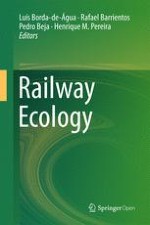
Open Access 2017 | OriginalPaper | Buchkapitel
17. Wildlife Deterrent Methods for Railways—An Experimental Study
verfasst von : Andreas Seiler, Mattias Olsson
Erschienen in: Railway Ecology
Aktivieren Sie unsere intelligente Suche, um passende Fachinhalte oder Patente zu finden.
Wählen Sie Textabschnitte aus um mit Künstlicher Intelligenz passenden Patente zu finden. powered by
Markieren Sie Textabschnitte, um KI-gestützt weitere passende Inhalte zu finden. powered by